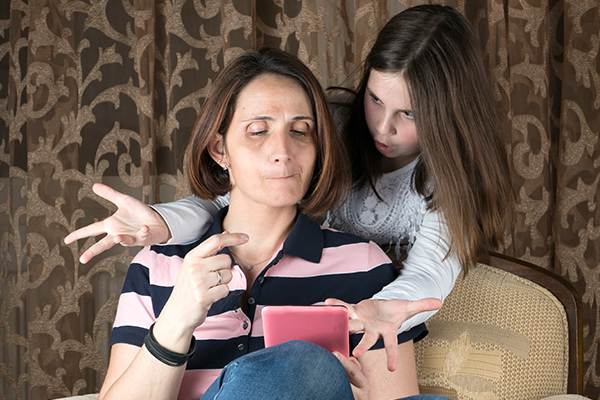Parenting in the digital age
By posting their children’s photos and personal information on social media sites, parents may be inadvertently exposing their children to dire consequences such as cyberbullying, identify theft, and even luring and sexual exploitation.

It was done in the name of innocent fun. For kicks-and-giggles, a mother decided to dress up her young son as a girl, complete with wig and full makeup. He looked so funny she posted the photo on her Facebook page, and the likes and good-natured comments from friends and relatives poured in – “Hilarious”, “LOL”, “So cute.” Harmless, right?
Fast-forward a few years. That boy is now a self-conscious teen. One of his peers finds the photo online and posts it on numerous social media sites. As the image spreads among his high school classmates, the boy feels intensely humiliated.
Partly based on a true story, this cyberbullying incident came to light during a series of focus groups held as part of a research project funded by the Office of the Privacy Commissioner of Canada (OPC): “Parenting in the digital age: Sharing personal information on social networks and its impact on children’s privacy and image rights.” Led by Christian Corbeil, Myriam Chagnon, and Josiane Fréchette of Option consommateurs, a consumer advocacy group, the team delved into the potential risks and impacts of ‘sharenting’ – the growing phenomenon of parents who obsessively share aspects of their children’s lives on social media, including photos, milestones, and personal information.


“The growing phenomenon of parents who obsessively share aspects of their children’s lives on social media, including photos, milestones, and personal information.”
Parents do seem to be posting about their little ones at every stage of development: First steps, first birthday, first day of school. Steeped in an ecosystem of online sharing, it seems hard for today’s parents to resist. But when they’re posting photos from Halloween or of the family pet, they likely don’t imagine worst-case scenarios – the possibility that someone, somewhere could use a photo or personal information for less than noble purposes, and that such misuse could take place years from when it was first shared.
Thorough Research
To begin identifying the possible risks of sharing children's personal information by parents on social networks, the OPC-funded research team analyzed the terms of use of several online services, such as Facebook and Instagram.
“We wanted to understand the obligations of social media sites and of the parents posting the information, and the possibilities, for example, for a child to delete information published by his or her parent,” explains Alexandre Plourde, a lawyer who works with Option consommateurs.
The team also conducted focus groups with two main demographics: Young adults whose parents may have shared their images and personal information online when they were younger, and vice versa – parents who may have shared photos and information about their own children. The goal was to gain insight into both parent and child perspectives on these practices – and what, if anything, they think should be done about sharenting.
The team then undertook a detailed analysis to identify gaps in the legal framework, particularly in the Personal Information Protection and Electronic Documents Act, and what legal mechanisms are being used to tackle these issues in other jurisdictions.
The resulting report garnered significant public and media attention. One of its main findings is that far more awareness is needed among parents about the potential hazards of publishing information about their kids on social media.
“While parents say they have some concerns about publishing information about their children on social networks, for the most part, they do it anyway,” says Plourde. “The parents we interviewed felt that this behaviour would not create risks for their children.”
The Risks to Children
What are risks of posting our kids’ pictures and personal information online?
At the very least, the report notes, parental notions of what is okay to share online may differ from those of their children. Parents may be creating an unwanted online presence for their child – one that many children, given the chance, would seek to delete.
For instance, focus group participants reported cases where online parental sharing caused significant embarrassment to their children, even leading to online bullying. Like in the earlier example of a mother innocently posting an image of her son dressed as a girl, classmates who want to ridicule another child can visit social networks to find embarrassing pictures and information on his or her parents’ accounts, and then share these with other classmates.
Even if a photo goes unnoticed by peers, online postings could cause major conflict between children and their parents. A child might ask a parent to remove a picture that was posted online, which he or she perceives as cringe-worthy or potentially humiliating. If the parent refuses to take it down, family turmoil can ensue.
Shockingly, a small proportion of parents have intentionally used social media in a malicious way, to purposely try and humiliate their child. One such situation that came up in the research was of a parent who had punished his child by forcibly marching his child to school. The parent videotaped the incident and subsequently posted it online, proving extremely humiliating for the child.
“All of these scenarios can be psychologically damaging to a child,” states Plourde. “Even if they are not the age of majority, young people deserve a right to personal dignity.”
Besides embarrassing or even damaging their children, whether purposely or not, parents can also unwittingly lay the ground for identify theft.
“When parents post a picture on the Internet of their child, it can be a real gold mine for fraudsters,” says Plourde. “If they post a picture at their child’s birthday party, fraudsters can figure out the child’s exact birthdate. Fraudsters can also search the parent's profile to discover the mother’s maiden name, the name of the child’s first pet, and so on. It's all data that can be used years later – even 10 years later – to commit identity theft, including applying for credit in the child’s name.”
In the most extreme cases, parental posts can lead to child luring or sexual exploitation.
“If parents post a picture of their child on the first day of school, it can reveal information to a malicious third-party, including the child's age, what neighbourhood they live in, what school they go to, and more,” warns Plourde. “Parents may not be aware of the extent of the information they are posting on the Web and the risks they are exposing their children to.”
Even innocent photos of children swimming or taking a bath have been illegally shared by pedophiles and posted on the dark web. These photos can be downloaded by someone who has access to the parents’ social media account and circulated everywhere on the Internet.
“These are really concrete problems and are not hypothetical at all,” states Plourde. “Anecdotally, after hearing about our research in the media or seeing our communications campaign, many parents told us they didn’t realize how much you can unveil with a simple photo. They reported changing the privacy settings on their social networks. Some parents also reported that they no longer reveal their child’s birthdate on social networks, or post back-to-school photos.”
“So many parents simply didn’t realize the risks, and have now changed their behaviours as a result of becoming more aware.”

Consent and Kids’ Rights

The potentially dire consequences of parents sharing their children’s information on social media sites begs several questions: Have children consented to have their images posted online in first place? Are they even in a position to consent, from a legal perspective? Can they opt to have the images and information deleted?
Ultimately, says Alexandre Plourde, since the children are minors, their guardians and other adults within their orbit – including parents, grandparents, extended family members, neighbours, and family friends – are making the choice to post about them. Currently, not only is a child unable to explicitly agree or disagree to have their photos and personal information shared, they also can’t make anything disappear once it’s in the virtual realm – even after they reach the age of majority.
Arguably, it would be better if Canada had a similar law to Europe’s General Data Protection Regulation (GDPR), so when children reached adulthood, they could elect to make any images and sensitive personal information disappear from the Internet. Also known as “the right to erasure”, it gives individuals the right to ask organizations to delete their personal data. The “right to be forgotten,” which received substantial press coverage after a judgment from the EU Court of Justice, set the precedent for the GDPR’s right of erasure provision.
Federally, Canada has yet to recognize a “right to be forgotten” or to enact erasure laws; however, injured parties can use the complaint procedure under the Personal Information Protection and Electronic Documents Act (PIPEDA).
At the provincial level, Quebec may be leading the charge in this area. In fall 2021, the Quebec National Assembly adopted Bill 64, an Act to modernize legislation surrounding the protection of personal information. Inspired by the European GDPR, the Act brings significant changes to Quebec privacy law in both the private and public sectors. Option consommateurs was called to appear as witnesses (in French only) before the Committee of the National Assembly studying the Bill, and, according to Plourde, some of their recommendations are reflected in the new Act.

Raising Awareness

Along with garnering significant news coverage on traditional media sites, Option consommateurs’ report on the risks of sharenting were amplified through social media, reaching an audience of more than 50,000. With OPC support, the organization also followed-up with two animated videos designed to educate parents about the potential risks. The bilingual videos were shared on Canada’s most popular social media sites, as well as with certain partners and their audiences. The consumer advocacy group also developed a web page that provides information on the risks to children, along with advice for parents on how to limit these risks when posting. Both the videos and web page have seen significant uptake, attracting close to 8,000 views to date.
Other articles from Real Results

 A Robot for Grandma?
A Robot for Grandma? 
 Digital Stalking on the Rise in Canada
Digital Stalking on the Rise in Canada 
 Is “Meaningful Consent” a Contradiction in Terms?: Three Design Jams Seek the Answer
Is “Meaningful Consent” a Contradiction in Terms?: Three Design Jams Seek the AnswerDisclaimer: The OPC’s Contributions Program funds independent privacy research and knowledge translation projects. The opinions expressed by the experts featured in this publication, as well as the projects they discuss, do not necessarily reflect those of the Office of the Privacy Commissioner of Canada.
- Date modified:

